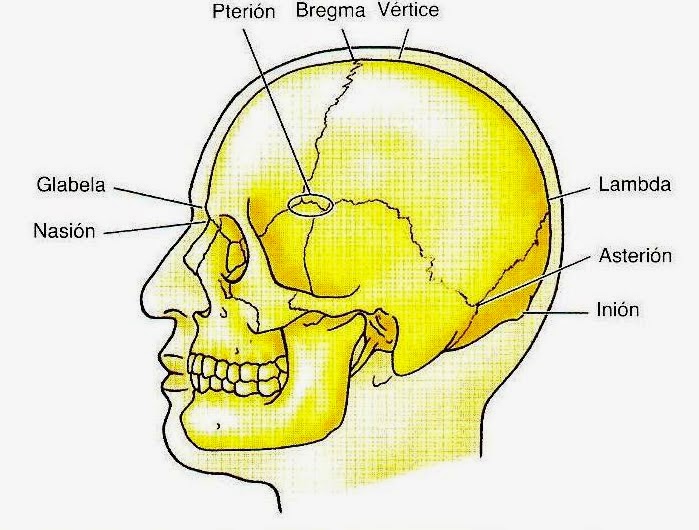The present document will show to the relation between uraken-uchi and
the well- known cranial fissure like pterion, giving rise to one of the most complicated to observe injuries in karate-do.
The reach of this one document is to demonstrate to the connection between the injury of the pterion and the pressure exerted by the
technique of uraken-chi with the esoteric Chinese technique of "death to
the four steps" or the like.
Uraken-uchi:
It consists of a mounted round attack with the arm, with the fist one hits or kentos with the knuckles on the surface to attack. Kamae or typical guard in karate-do begins from the position of. Flexing,
like means, the arm forwards and turning slightly, with the relaxed
fist, fist esta, obtains a movement in snap, so and as they show the
attached photographies. At the moment of the impact the fist is contracted, as a mace, leaving
the relaxed wrist, and strikes, as it were indicated or above, with the
upper part of the knuckles or kentos located in the back of the hand.
At the moment of the collection all the upper extremity is used due to
relax, making himself a soft movement of snap but in inverse sense.
Important
points in the accomplishment of esta technique are the turn of the hip
and, therefore, of the upper trunk, with a sensation of speed that can
only be obtained with the overall relaxation of the body. This relaxation is interrupted only at the moment of the impact on the objective. The force of the impact is only obtained with speed, and the collection must be very agile.
Another important point is that the impact is much more important as if the
technique is made in movement, since the kinetic energy of the body in
Its movement is added unloading that exactly at the moment of the
impact. This is very indicated in kumite fights or regulated.
In
order to avoid injuries of the elbow bend this one must be solely
without arriving at its mechanical limit, that is to say, that the
opening of the elbow must arrive until 160/170 from 180 possible. With injuries in the joint it will be avoided, synovial bones and meetings.
The objectives are to reach, basically, the head and the face of the opponent. The
author recognizes that there are in other styles like plexus morning
calls to pave or, even, the lower part of the armpits, but due to their
experience in kumite fights or regulated (and even within the scope of
the self-defense) does not recommend in original points, preferring to recommend the face and the head like preferred objectives.
These points can be the nose, the lower part of the jaw (Where there
mind the nerve is located) and the pterion, that is the object of the
present work.
The pterion:
It is the union of the greater wing of the sphenoid, squamous portion of the temporary bone, frontal bone and parietal bone; average covers the passage with the previous branch of the meningeal artery.
The pterion is an important clinical reference, because it overlaps
the anterior branches of meningeal vessels means located in the grooves
of the inner face of the inner wall of the shell or calvaria.
The pterion two thick finger is placed above the zygomatic arch and a finger above the frontal process of the zygomatic bone.
Results:
A
head blow, which can be an accident, or an art karate-do as the
uraken-uchi at hand, can fracture the fine bones that form the pterion,
breaking below an artery for example, that may be the anterior branch of the middle meningeal artery crossing at that point. The resulting hematoma (collection of blood or accumulation) compresses the cerebral cortex underneath. The bleeding from the middle meningeal artery untreated can cause death within one hour or fulminant.
Blood torn branches a middle meningeal artery accumulates between the outer periosteal layer of the dura mater and calvarium. This happens blows on the head. It is called an extradural or epidural hematoma. In usual cases a shock or loss of short knowledge lucid interval followed by a few hours is observed. Then drowsiness and coma with deep unconsciousness is established. Compression happens as the brain hematoma thickens and increases the mass of blood that puts pressure. It is then necessary to evacuate the blood and suture the bleeding vessels, all require surgical intervention.
As
is easy to see, it is observed that the old Chinese assertion death
within hours or death to the four steps is entirely attributable,
according to personal opinion of the author, the existence of aneurysms
and cranial hematomas that can cause death within minutes.
Conclusions:
Given
the danger of the technique shown above, the author strongly practice
in a dojo or school of karate-do, always with qualified personnel who
can colegiar students within proper execution recommends, always
respecting the opponent and to be taught the dangers underlying this technique. All with the goal of eliminating injuries from both the executor and the receiving uraken-uchi.
Bibliography:
The dynamics of karate, Masatoshi Nakayama, editorial Fher, 1966.
Clinically Oriented Anatomy, Keith L. Moore and others, editorial Panamericana, 4th edition, 2000.
Photographs and personal references of the author on the Internet.























